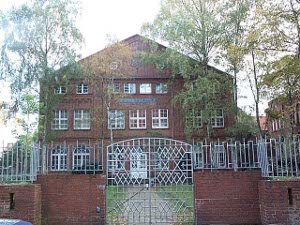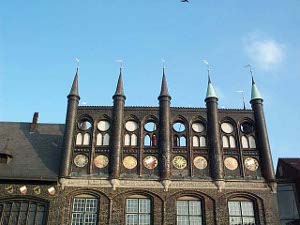 Altona statue
so much graffiti.
Altona statue
so much graffiti.
A short walk on a lovely morning took us to Dag Hammarskjold Platz, where we found Dammtor, another Hamburg railroad station. From Dammtor we took the S-Bahn train to Altona. Everything along the train track seemed to be covered with graffiti; it reminded us of Los Angeles. Although we haven't heard or read anything about activities of juvenile gangs, they must be very active to cause  Altona statue
so much graffiti.
Altona statue
so much graffiti.
Altona is about fifteen minutes from downtown Hamburg, even with all the stops. It's one of many towns which were absorbed as the city limits kept expanding. But the old town buildings are still around: train station, city hall, shopping district, etc. We took a short walk from the train station to the shore of the Elbe River, where the city workers were busily blowing the autumn leaves around with big loud machines.
At the entrance to a city park we found a memorial plaque to the Cohn family of Altona. This Jewish family had played a major role in the life of Altona for over 300 years. The plaque traced the genealogy of Betty Levi, whose mother was a Cohn. Betty's four children had fled Germany in the 1930s, but Betty, a widow alone, stayed on; she was killed in Auschwitz in 1943. The street was named after her.
Returning to the train station we headed for Wedel, which is still a suburb, at the end of the S-Bahn line. On the way to Wedel the train pulled  Liberian Ship, Wedel
into the station at Blankenese, then backed up and went the rest of the way to Wedel going backwards. Not that it matters much to a train.
Liberian Ship, Wedel
into the station at Blankenese, then backed up and went the rest of the way to Wedel going backwards. Not that it matters much to a train.
At the Wedel train station we were approached by a man who had a postcard showing a statue of Roland, the legendary knight (who may have been a Basque) who died leading the rear guard of Charlemagne's army, which was fleeing across the Pyrenees from a much larger force of Moors. The man said there was also a statue of Roland in Wedel, and then went on to indicate (we think) that Roland spoke with a lisp. Did we know about the Willkommhoeft? Yes, we were going there.
So again we walked down to the Elbe, through the town of Wedel, observing that very few stores took credit cards, unlike the U.S. Our timing was perfect, because as we reached the river, a Liberian ship was sailing down to the North Sea. The Willkommhoeft, a shore station, hoisted the Liberian flag, played the Liberian national anthem, and said, "Hamburg wishes you a pleasant voyage." We  Luebeck canal scene
suggest to our Coast Guard friends that this would be a good project in U.S. harbors to build good will with foreign shippers and seamen!
Luebeck canal scene
suggest to our Coast Guard friends that this would be a good project in U.S. harbors to build good will with foreign shippers and seamen!
On the way back through town to the Wedel train station, we saw the same man, who had evidently buttonholed one of the townspeople and perhaps was telling him about Roland.
Returning to the Hamburg Hauptbahnhof, we boarded a train to Luebeck. which has been designated a United Nations World Heritage Site, because it has managed to retain much of its medieval character through fires, floods and bombings.
We picked up the only English-language guide to Luebeck in the railroad station, and it turned out to be a gem.
Although Hamburg is Germany's biggest port, Luebeck is Germany's biggest  Tiny yard and alley
Baltic port, and Luebeck was also the headquarters of the Hanseatic League, which was a dominant force in Northern European politics in the fourteenth century. The three cities of Hamburg, Bremen, and Luebeck were also free cities, which retained a great deal of independence when they came under the German Empire in 1871. In fact this independence was not lost until the Nazis passed the "Greater Hamburg Law" in 1937, which brought these cities under the Third Reich. Luebeck tried unsuccessfully to regain its independence after WW II.
Tiny yard and alley
Baltic port, and Luebeck was also the headquarters of the Hanseatic League, which was a dominant force in Northern European politics in the fourteenth century. The three cities of Hamburg, Bremen, and Luebeck were also free cities, which retained a great deal of independence when they came under the German Empire in 1871. In fact this independence was not lost until the Nazis passed the "Greater Hamburg Law" in 1937, which brought these cities under the Third Reich. Luebeck tried unsuccessfully to regain its independence after WW II.
Although Luebeck was bombed in 1942, it managed to be designated by the International Red Cross as the harbour for the importation of gift parcels to be delivered to POWs in Germany; this spared it from further bomb damage.
Although the city of Luebeck was part of West Germany, it was on the border with East Germany, which contained many of Luebeck's surrounding towns and suburbs. So it has undergone quite a renaissance since German reunification.
The old city of Luebeck is an island, which was heavily fortified for defense during the middle ages. The main gate, or Holstentor, was completed in 1478, and is still standing.
 Synagogue
Synagogue
Citizens were required to live within the town walls, so landowners soon began to put up tiny houses and sheds behind their houses, making wonderful profits and creating a snarl of alleyways in the process. Our walking tour led us up and down these tiny alleys, which have to be seen to be believed. For example, "Einmannstrasse" has a name that is based on its size.
The 17 meter triumphal cross in the cathedral was completed in 1477; it required six years to restore it after WW II, but it is quite beautiful.
We also saw perhaps the only synagogue in Northern Germany that was not destroyed on Kristallnacht; it was judged to be too close to the Convent of St. Anne to be burnt.
The last sight we saw before we decided to return to our hotel in Hamburg  Town Hall
was the Luebeck Rathaus, begun in 1230, and truly a wonderful building.
Town Hall
was the Luebeck Rathaus, begun in 1230, and truly a wonderful building.
When we got back to our hotel, we had ridden six separate trains, counting the subway, and taken 37 pictures (they weren't all keepers).
In our hotel room we found a big cardboard box, which contained a white teddy bear named Cuddles. We are to be Cuddles' traveling companions for a while, according to the instructions contained in her backpack. We must send postcards to Ms. Bennett's fourth grade at Amelia Earhart School in Alameda, California. The students, including our granddaughter Emily, will learn geography and mensuration from Cuddles' travels during the year.
If there are any other travelers on our mailing list who would be willing to take along a white teddy bear for a while, please let us know and we'll try to pass her along to you. Ms. Bennett's success rate (in terms of number of teddy bears returned at the end of the school year) is better than 90%.